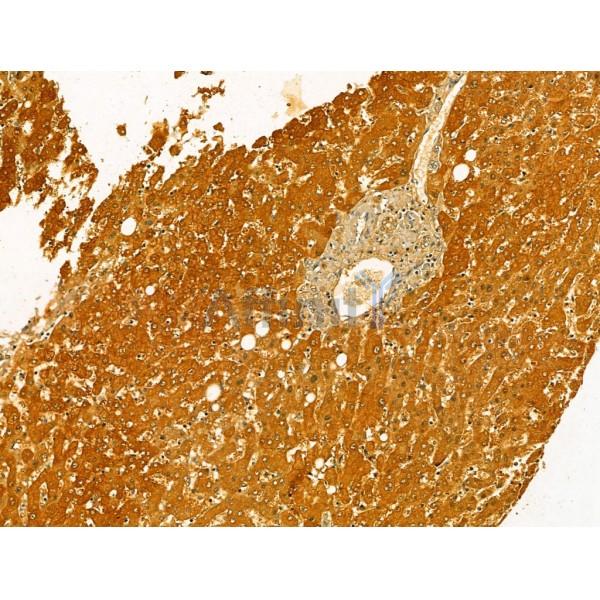PKLR Antibody - #DF12221
| Product: | PKLR Antibody |
| Catalog: | DF12221 |
| Description: | Rabbit polyclonal antibody to PKLR |
| Application: | WB IHC IF/ICC |
| Reactivity: | Human, Mouse, Rat |
| Prediction: | Pig, Bovine, Horse, Rabbit, Dog, Xenopus |
| Mol.Wt.: | 58 kDa; 62kD(Calculated). |
| Uniprot: | P30613 |
| RRID: | AB_2845026 |
Related Downloads
Protocols
Product Info
*The optimal dilutions should be determined by the end user. For optimal experimental results, antibody reuse is not recommended.
*Tips:
WB: For western blot detection of denatured protein samples. IHC: For immunohistochemical detection of paraffin sections (IHC-p) or frozen sections (IHC-f) of tissue samples. IF/ICC: For immunofluorescence detection of cell samples. ELISA(peptide): For ELISA detection of antigenic peptide.
Cite Format: Affinity Biosciences Cat# DF12221, RRID:AB_2845026.
Fold/Unfold
EC 2.7.1.40; KPYR_HUMAN; L-PK; Pk-1; PK1; PKL; Pklg; Pklr; PKR; PKRL; Pyruvate kinase 1; Pyruvate kinase isozymes R/L; Pyruvate kinase liver and blood cell; Pyruvate kinase liver and RBC; Pyruvate kinase liver and red blood cell; Pyruvate kinase liver type; Pyruvate kinase type L; Pyruvate kinase, red cell type; R type/L type pyruvate kinase; R-PK; R-type/L-type pyruvate kinase; Red cell/liver pyruvate kinase; RPK;
Immunogens
A synthesized peptide derived from human PKLR, corresponding to a region within the internal amino acids.
- P30613 KPYR_HUMAN:
- Protein BLAST With
- NCBI/
- ExPASy/
- Uniprot
MSIQENISSLQLRSWVSKSQRDLAKSILIGAPGGPAGYLRRASVAQLTQELGTAFFQQQQLPAAMADTFLEHLCLLDIDSEPVAARSTSIIATIGPASRSVERLKEMIKAGMNIARLNFSHGSHEYHAESIANVREAVESFAGSPLSYRPVAIALDTKGPEIRTGILQGGPESEVELVKGSQVLVTVDPAFRTRGNANTVWVDYPNIVRVVPVGGRIYIDDGLISLVVQKIGPEGLVTQVENGGVLGSRKGVNLPGAQVDLPGLSEQDVRDLRFGVEHGVDIVFASFVRKASDVAAVRAALGPEGHGIKIISKIENHEGVKRFDEILEVSDGIMVARGDLGIEIPAEKVFLAQKMMIGRCNLAGKPVVCATQMLESMITKPRPTRAETSDVANAVLDGADCIMLSGETAKGNFPVEAVKMQHAIAREAEAAVYHRQLFEELRRAAPLSRDPTEVTAIGAVEAAFKCCAAAIIVLTTTGRSAQLLSRYRPRAAVIAVTRSAQAARQVHLCRGVFPLLYREPPEAIWADDVDRRVQFGIESGKLRGFLRVGDLVIVVTGWRPGSGYTNIMRVLSIS
Predictions
Score>80(red) has high confidence and is suggested to be used for WB detection. *The prediction model is mainly based on the alignment of immunogen sequences, the results are for reference only, not as the basis of quality assurance.
High(score>80) Medium(80>score>50) Low(score<50) No confidence
Research Backgrounds
Plays a key role in glycolysis.
Belongs to the pyruvate kinase family.
Research Fields
· Human Diseases > Endocrine and metabolic diseases > Type II diabetes mellitus.
· Human Diseases > Endocrine and metabolic diseases > Non-alcoholic fatty liver disease (NAFLD).
· Human Diseases > Endocrine and metabolic diseases > Maturity onset diabetes of the young.
· Metabolism > Carbohydrate metabolism > Glycolysis / Gluconeogenesis.
· Metabolism > Nucleotide metabolism > Purine metabolism.
· Metabolism > Carbohydrate metabolism > Pyruvate metabolism.
· Metabolism > Global and overview maps > Metabolic pathways.
· Metabolism > Global and overview maps > Carbon metabolism.
· Metabolism > Global and overview maps > Biosynthesis of amino acids.
· Organismal Systems > Endocrine system > Insulin signaling pathway. (View pathway)
Restrictive clause
Affinity Biosciences tests all products strictly. Citations are provided as a resource for additional applications that have not been validated by Affinity Biosciences. Please choose the appropriate format for each application and consult Materials and Methods sections for additional details about the use of any product in these publications.
For Research Use Only.
Not for use in diagnostic or therapeutic procedures. Not for resale. Not for distribution without written consent. Affinity Biosciences will not be held responsible for patent infringement or other violations that may occur with the use of our products. Affinity Biosciences, Affinity Biosciences Logo and all other trademarks are the property of Affinity Biosciences LTD.






